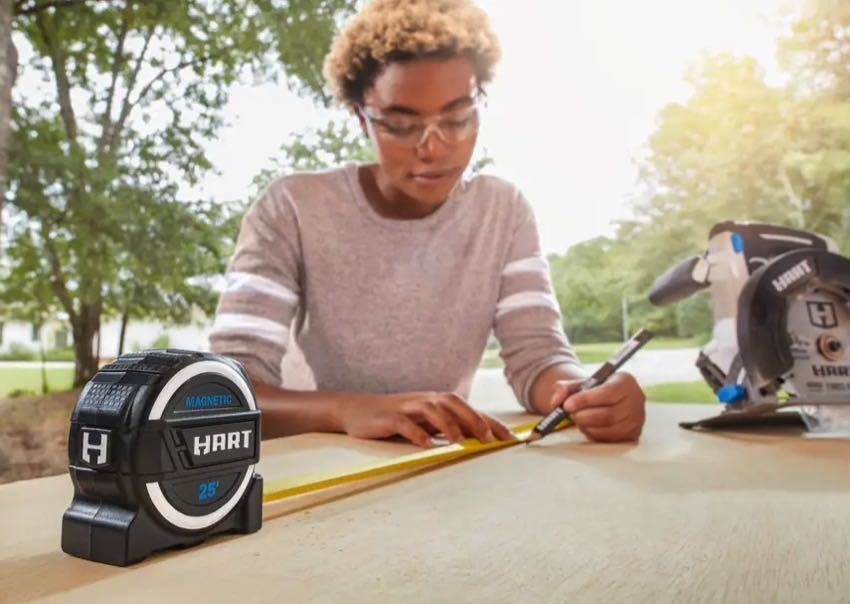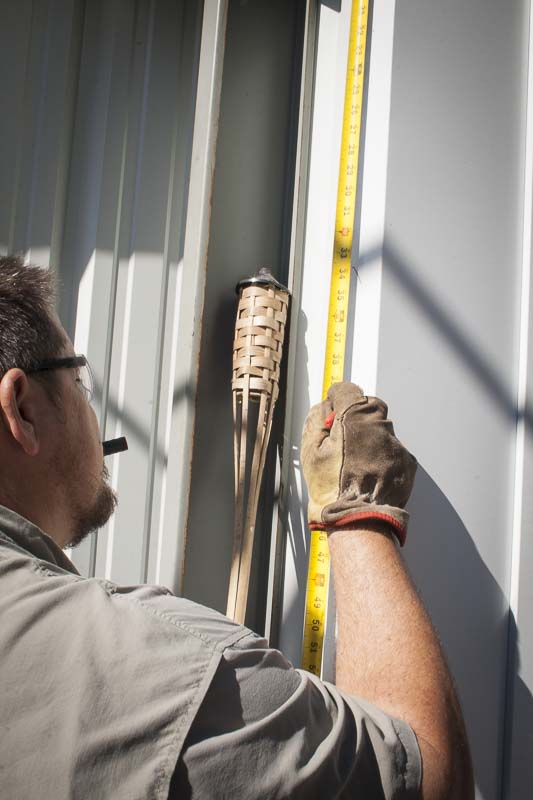It all started when my brother-in-law decided it would be a great idea to put a 60′ x 33′ foot metal building on his 5-acre property. This is a building that the supplier says should take a handful of guys three days to build, but which will invariably take us three months. In our hands, it’s like an erector set for men who are used to playing with Lincoln logs. Needless to say, with a building that big, the Hart magnetic tape measure suddenly seemed like more of a necessity than a “nice-to-have”.
Editor’s Note: Think you know everything about tapes? Check out our article on how to read a tape measure and we promise you’ll learn something new!
Serendipitously, Hart sent us a pair of their tape measures—which just so happen to have a magnet on the front of the hook. I grabbed the 16-foot and gave the 25-foot Hart tape measure to my brother-in-law. He was going to need it with all those steel spans and sheet metal. I’m no stranger to reviewing tapes. Our best tape measure article compares tons of tapes for durability, features, and (of course) standout.
Hart Tape Measure Quick Feature Overview
Magnetic Tang
The rare hook magnet on the Hart tape allows you to fly it across gaps, grab onto steel studs and beams, and make measurements that would typically require a second person. Vertical inside measurements particularly benefited from this handy feature.
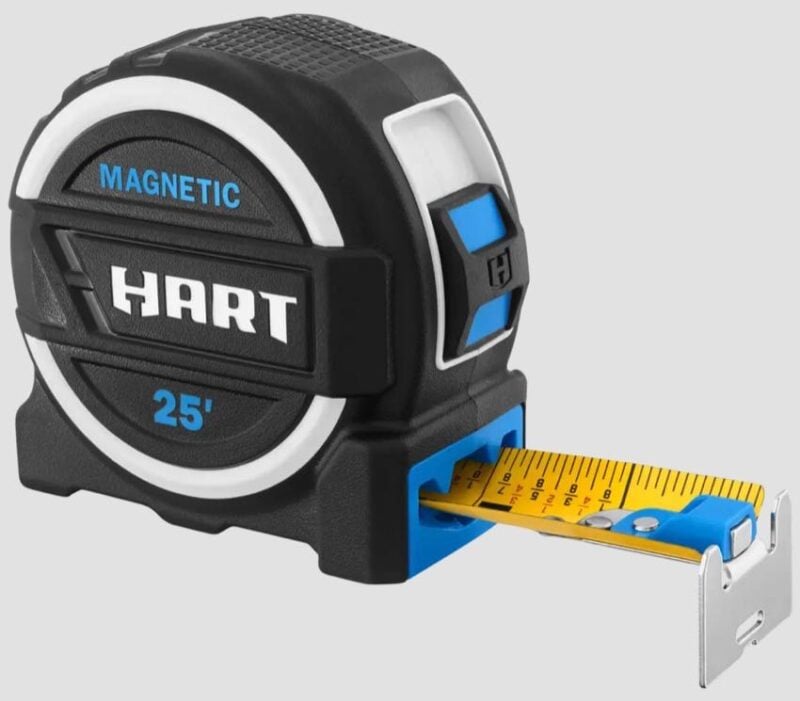
Blade Brake
The blade brake is so conveniently located, you almost don’t need to know about it in order to use it. Where your hand naturally grips the tape tighter during a retract is where the brake sits. That means it’s a very simple matter of using the tape normally while you control the retract speed and avoid injury or inconvenience due to the tape snapping back at you or cutting your hand due to excessive speed. I threw the metal tape out of the case several times and used the brake to gently guide it back in, slowing it naturally and mindlessly. You don’t even have to think about it.
Belt Clip
The belt clip on the Hart tape measure is small but functional. The clip holds securely to a belt (pants or tool belt) and there’s enough of a gap at the base of the clip to allow you to slip it over the loop on carpenter pants, or anywhere else you can catch an edge. Most tapes I use have those flat clips that actually contact the casing and form a “pinch point”. They require two hands to guide onto anything, and they’re really not all that user-friendly. Most of the time you end up loosening them up with a flathead screwdriver to make them a bit more pliable.
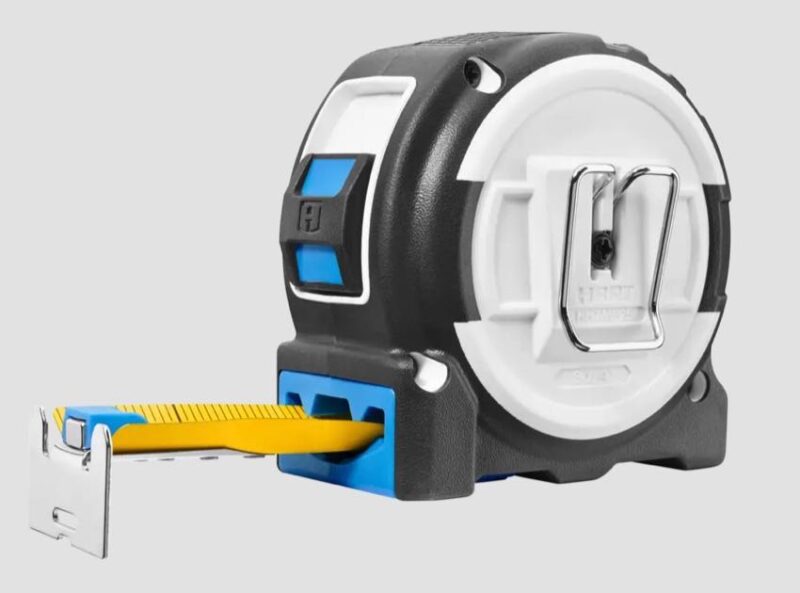
Grip and Handling
There is a nice rubberized grip along the top of the Hart tape that wraps all the way down the back of the tool and across the bottom, stopping at the blade brake. It lets you hold the tape very securely in your hands, regardless if you’re wearing gloves, or you have greasy or oily palms. The tape lock is also rubberized, making it easy to activate at almost any angle. This is just a well-thought-out case that yields a tool that is easy to hold, difficult to drop, and which is sized perfectly for the hand. In terms of durability, we didn’t do any destructive testing, but the plastic shell looked about as solid as any I’ve seen made from the same or similar material. Between the metal clip and the rubberized coating, it looked like it could take a beating and come out swinging.
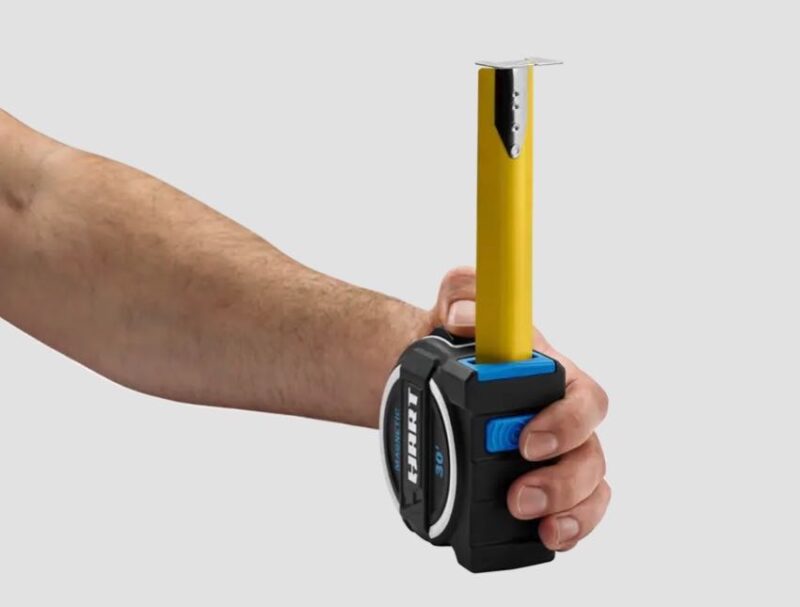
Standout, Accuracy, and Other Features
The Hart magnetic tape measures have a decent standout—around 11 feet on a non-windy fay. It feels secure, and (like other tapes) you get more distance when you extend your left hand under the tape to steady it at its farthest point. Standout is the “go-to” test for tape measures, but there are other considerations that would make me choose a tape with a shorter stand-out over another with a longer range. For one, the Hart tape is around an inch wide, so that standout is accomplished without having the tool that’s as wide as a roll of duct tape in your hand.
The scale on the Hart tapes is nothing to write home about. The single-sided solution lacks the vertical measurements of their former model (before they appeared in Walmart stores nationwide). Red inch marks to tick off anything over 12 inches. I can’t tell you how many tapes I’ve worn down where I can no longer read anything under about 16 inches. Hopefully, the Hart will last a bit longer in the field.
Testing Accuracy
Accuracy was dead-on to within +/-.0005″. We tested the scale with the Lixer Gage Block tape measure calibration tool that is NIST certified and a great way to test how accurate each side of the tang is for both push and pull.
Conclusion
There’s no doubt that Hart is really hitting the market hard with these tape measures. We’ve used both the 16′ and 25′ models extensively, and I believe this will be a very popular tape for construction professionals. As a whole, this is now one of my favorite tapes, and I see no reason it won’t get a similar response when people begin to pick it up and hold it in your hands. By the way, that’s exactly what I recommend you do. Pick it up. Hold it and use it to see if you like the features as much as I do. My guess is that you will.
Available in a wide variety of sizes and styles, you can find Hart tape measures from under $5 all the way up to $20 for their 35-ft Pro model. At those prices, I don’t know why everyone wouldn’t want to pick one out for themselves to try!

